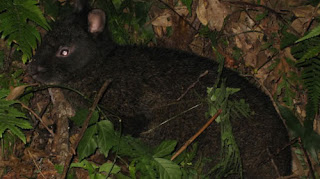True Wild Life | Amami Rabbit | The Amami Rabbit or Amamino kuro usagi, also known as the Ryukyu Rabbit, is a primitive dark-furred rabbit which is only found in Amami Ōshima and Toku-no-Shima in Japan. The dark-furred Amami Rabbit is known as a living fossil. Its characteristics are identical to rabbits who lived five million years ago. With its small ears and dark eyes the Amami Rabbit (Pentalagus furnessi) contrasts greatly with its more familiar fluffy, white relatives, and yet it's the Amami's distinctive features that make this rabbit so important to the study of the animal world. The Amami Rabbit has remained essentially unchanged since the Miocene Epoch of the Neogene Period, or approximately five million years. It is believed that its ancestors diverged from other leporids, or rabbits and hares, approximately 20 million years ago.
The Amami Rabbit has thick, wooly, dark brown fur that takes on a reddish shade on its underbelly as it ages. It has small ears and small eyes and short legs, but a large, stocky body. It also has a longer face, or snout, than most rabbits. Amami Rabbits do not have tails. They do, however, have long, curved, inch-long nails.
Baby Rabbits are called kits, kittens, or bunnies. Some sources say the Amami Rabbit only has one kit at a time, and other sources say they have two to three, but it is agreed that they generally have two litters each year. The mother builds a den lined with plant materials and tufts of fur then seals the top with the same material so it looks like the rest of the forest floor. Like other rabbits, the mother leaves her offspring to hunt and only returns every other night in an effort to keep predators from locating her den. She can even feed the kit without completely uncovering the den. She unseals the den when the kit is between four and seven weeks old and the baby rabbit joins its mother on the evening hunt for food.
The Amami Rabbit eats grass, fresh branches, and nuts. The Amami Rabbit raises its offspring in rabbit holes. Except at times when the mother feeds milk to her offspring, she will cover the rabbit hole with dirt to conceal it. Isn't that clever!
The reason why the Amami Rabbit retains its primitive form is because this form best suits them for life on the island. But as more people came to the island, the environment started to change. People continued to cut down trees, wiping out sources of food and refuge for the Amami Rabbit. Amami Rabbits are also frequently attacked by mongooses, which were originally brought to the island to exterminate the Habu, a venoemous snake. Today, the Amami Rabbit is on the brink of extinction.



















.gif)



